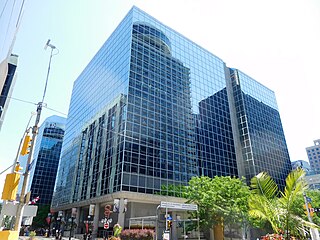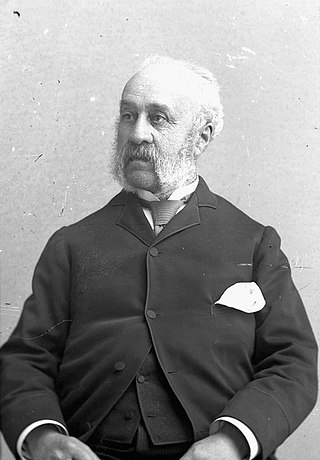
Parliament Hill, colloquially known as The Hill, is an area of Crown land on the southern bank of the Ottawa River in downtown Ottawa, Ontario, Canada. It accommodates a suite of Gothic revival buildings whose architectural elements were chosen to evoke the history of parliamentary democracy. Parliament Hill attracts approximately three million visitors each year. The Parliamentary Protective Service is responsible for law enforcement on Parliament Hill and in the parliamentary precinct, while the National Capital Commission is responsible for maintaining the nine-hectare (22-acre) area of the grounds.

Thomas D'Arcy McGee was an Irish-Canadian politician, Catholic spokesman, journalist, poet, and a Father of Canadian Confederation. The young McGee was an Irish Catholic who opposed British rule in Ireland, and was part of the Young Ireland attempts to overthrow British rule and create an independent Irish Republic. He escaped arrest and fled to the United States in 1848, where he reversed his political beliefs. He became disgusted with American republicanism, Anti-Catholicism, and Classical Liberalism. McGee became intensely monarchistic in his political beliefs and in his religious support for the embattled Pope Pius IX.
Bytown is the former name of Ottawa, Ontario, Canada. It was founded on September 26, 1826, incorporated as a town on January 1, 1850, and superseded by the incorporation of the City of Ottawa on January 1, 1855. The founding was marked by a sod turning, and a letter from Governor General Dalhousie which authorized Lieutenant Colonel John By to divide up the town into lots. Bytown came about as a result of the construction of the Rideau Canal and grew largely due to the Ottawa River timber trade. Bytown's first mayor was John Scott, elected in 1847.

The Office of the Prime Minister and Privy Council building, formerly known as the Langevin Block, is an office building facing Parliament Hill in Ottawa, Ontario, Canada. As the home of the Privy Council Office and Office of the Prime Minister, it is the working headquarters of the executive branch of the Canadian government.

The C.D. Howe Building is an office tower in Ottawa, Ontario, Canada, that is the home of Innovation, Science and Economic Development Canada, the Office of the Auditor General and other smaller tenants. It was built by Olympia and York. The federal government sold the land to O&Y for a dollar and signed an agreement to lease the final building for a set rate until 2012. The eleven-story building was opened in 1978.

Sparks Street is a pedestrian mall in Ottawa, Ontario, Canada. It was a main street in Ottawa that was converted into an outdoor pedestrian street in 1967, making it the earliest such street or mall in Canada.

Downtown Ottawa is the central area of Ottawa, Ontario, Canada. It is sometimes referred to as the Central Business District and contains Ottawa's financial district. It is bordered by the Ottawa River to the north, the Rideau Canal to the east, Gloucester Street to the south and Bronson Avenue to the west. This area and the residential neighbourhood to the south are also known locally as 'Centretown'. The total population of the area is 5,501.

Thomas Fuller was an English-born Canadian architect. From 1881 to 1896, he was Chief Dominion Architect for the Government of Canada, during which time he played a role in the design and construction of every major federal building.

Patrick James Whelan was an Irish-born tailor and suspected Fenian supporter who was executed after the assassination of Irish journalist and politician Thomas D'Arcy McGee in 1868. He maintained his innocence throughout the proceedings. Questions about his guilt continue to be voiced, as his trial was "marred" by political interference, dubious legal procedures, allegations of bribing witnesses and easily discredited testimony.

The history of Northwest Territories capital cities begins with the purchase of the Territories by Canada from the Hudson's Bay Company in 1869, and includes a varied and often difficult evolution. Northwest Territories is unique amongst the other provinces and territories of Canada in that it has had seven capital cities in its history. The territory has changed the seat of government for numerous reasons, including civil conflict, development of infrastructure, and a history of significant revisions to its territorial boundaries.

Thomas Ahearn, PC was a Canadian inventor and businessman. Ahearn, a native of Ottawa, Canada West, was instrumental in the success of a vast streetcar system that was once in Ottawa, the Ottawa Electric Railway, and was the first chairman of Canada's Federal District Commission in 1927. He held several patents related to electrical items and headed companies which competed for decades with Ottawa Hydro as providers for electricity in Ottawa. Ahearn co-founded the Ottawa Car Company, a manufacturer of streetcars for Canadian markets.

The Bytown Museum is a museum in Ottawa located in the Colonel By Valley at the Ottawa Locks of the Rideau Canal at the Ottawa River, just below Parliament Hill. Housed in the Commissariat Building, Ottawa's oldest remaining stone building, the museum provides a comprehensive overview of the origins of Bytown and its development and growth into the present city of Ottawa.

The Central Post Office is a historic building in Ottawa, Ontario, Canada. The building was completed in 1939, replacing a Second Empire style office built in 1876. This original office was located in what is today Confederation Square, and was demolished in order to construct the grand public space. The new office was designed by W.E. Noffke, it is located on the western edge of the square at the end of Sparks Street. The new site required the demolition of the Royal Bank of Canada building. The office combines the distinctly Canadian Chateauesque style with Art Deco elements. It is noted for the decorative carved lions arranged around its base.

Bernard Devlin, was an Irish-born lawyer, counsel to the Abraham Lincoln administration of the United States Government during the most northerly engagement of the United States Civil War, Quebec-based political figure and Canadian parliamentarian, and peer and political competitor of Thomas D'Arcy McGee. A champion of many causes, generally of a liberal persuasion, his abilities as a criminal advocate and oratorical skill established for him a wide reputation throughout the then-Dominion of Canada, and his motto: "justice and equality to all classes and creeds, undue favor to none" was far in advance of the tenor of the times.

The Dominion Police Force was the federal police force of Canada between 1868 and 1920, and was one of the predecessors of the Royal Canadian Mounted Police. It was the first federal police force in Canada, formed the year following the Canadian Confederation to enforce federal laws and perform policing duties for the Federal Government of Canada. On 1 February 1920, the Dominion Police was merged with the Royal North-West Mounted Police to form the Royal Canadian Mounted Police as the new federal police force of Canada.
This is a timeline of the history of Ottawa.
Royal Bank Building or Royal Bank Tower may refer to:

State funerals in Canada are public events held to commemorate former governors general, prime ministers, other members of the cabinet who died in office, and, at the cabinet's discretion, other eminent Canadians. With ceremonial, military, and religious elements incorporated, state funerals are offered and executed by the governor general-in-council, who provides a dignified manner for the Canadian people to mourn a national public figure. Provincial and territorial governments may also perform state funerals for citizens in their particular jurisdictions. However, most state funerals are federal affairs.
The history of Ottawa, capital of Canada, was shaped by events such as the construction of the Rideau Canal, the lumber industry, the choice of Ottawa as the location of Canada's capital, as well as American and European influences and interactions. By 1914, Ottawa's population had surpassed 100,000 and today it is the capital of a G7 country whose metropolitan population exceeds one million.
















